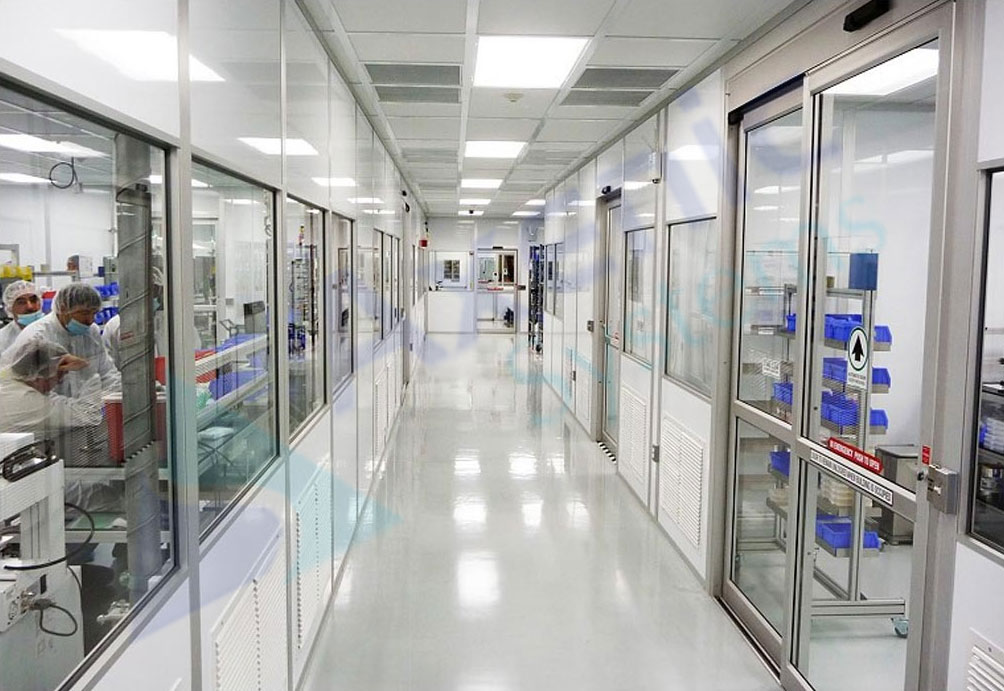Axenic System is one of the leading company engaged in architectural
designing, planning, installation, commissioning of HVAC and Turnkey
construction for cleanroom projects
Medical Device Cleanrooms
Table of Contents

Medical Device Cleanrooms
AXENIC SYSTEMS (established in 1995) is one of the leading companies engaged in planning and installing of Medical Device Cleanrooms to carry out the medical device manufacturing process. Medical Device Cleanrooms vary between class 1 and 9. Medical Device Cleanrooms ensure the safety & security of both equipment operators and end-users in industries like science and technology, E-liquids, healthcare, as well as food production.
Medical Device Cleanrooms are hygienic air environments where a particular size of air particulates is prohibited from entering. Cleanrooms keep air contaminants controlled during manufacturing and operations in industries like E-liquids, science and technology, healthcare, as well as food production.
Our Medical Device Cleanrooms are established to meet the necessary standard of the international organisation for standardisation (ISO) 14644-1: 2015. Vaporized particles, bacteria, pathogens, chemical vapours, fibrous materials and more, are kinds of pollutants that can hurt the medical device manufacturing process.
Medical Devices Cleanrooms vary between class 1 and 9. The arrangement of each Cleanroom changes depending on size and occurrence of the air particulates in the cleanroom. The Class 1 classification is the supreme in the range and it is tested for the lowest frequency and smallest particle size while the Class 9 classification signifies the least in the range and is valued based on a higher frequency and greater air pollutants present in the cleanroom at any specified time.
Advantages offered by Medical
The use of Medical Devices Cleanrooms benefits medical device companies in many ways. They ensure the safety & security of both equipment operators and end-users and help manufacturers enhance profitability on a large scale. The major advantages include:
Device Cleanrooms
- Protecting the users: Producing medical devices that are devoid of pathogens protects the health of patients and healthcare service providers against biological infection.
- Protecting the employees – Some raw materials used in the medical device fabrication cycle produce impurities that could be harmful to operators. Medical Devices Cleanrooms protect floor operators using measures such as protective equipment, growing areas, and air filtration systems to keep the immediate surroundings safe for workforces.
- Securing medical device authorizations – Successfully marketing medical devices on an international scale means manufacturing them in a cleanroom that encounters all of the diverse international standards that apply where the device is to be sold. Implementing these international standards provides manufacturers access to a larger customer base, thus increasing productivity.
Class options of Medical Devices Cleanrooms
| Type of Process | Cleanroom Class |
| Aseptic manufacturing and filling | Class 100/ISO5 |
| Assembly and packaging of devices that will be terminally sterilized where low particle count on devices is desired | Class 10,000/ISO7 |
| Convenience kits and assembly of medical devices that need to be free of visible particles | Class 100,000/ISO8/controlled environment |
| Manufacturers that repackage and/or re-label unpackaged bulk devices contract sterilizers, and re-manufacturers that change the original condition of devices, | Subject to QS (Quality Systems)/GMP (Good Manufacturing Practices) |
| Pharmacy Drug compounding (per USP website) | Class 100 hood in class 10k room |
| Monitoring | Method |
| Air – Particle count | Air sampler (particle counter) |
| Work surfaces – microbes | Surface contact plates or settling plates |
| Regulations | |
| Airborne particulate cleanliness | FED-STD-209E |
| Personnel training | 820.25 ( QS) |
| Buildings | 21 CFR 820.70 (QS) |
| Cleaning Procedures | CFR 820.70 (QS) |
| Pharmacy Drug compounding | USP797 |
Working procedure
The quantity and sizes of air particulates maintained in Medical Device Cleanrooms are attained through the use of HEPA/ULPA filtering technology. This technique is technically proven to filter out different sizes and amounts of pollutants in the air entering the cleanroom. Non-filtered air passes through Filter Fan Units (FFUs) forming a positive pressure area inside the cleanroom. Contamination is controlled in the clean air environment by means of the positive pressure as it stops non-filtered air from flowing back into the cleanroom through exhaust openings.
The Medical Devices Cleanroom technology considerably reduces the probabilities of product pollution and is the first step in developing a clean air area for production. The second steps that are taken in justifying contamination are measures that will avoid cleanroom personnel from bringing in contaminants. This introduction of pollutants can be prevented by the appropriate use of Cleanroom PPE such as gowning, hair nets and overshoes. This will decrease fibres and potential contaminants from entering the Medical Devices Cleanroom and interfering with Production/ research. Workers of Medical Devices Cleanrooms must be sufficiently trained on contamination reduction procedures to keep the Cleanroom safe from contamination.
Construction
Medical Device Cleanrooms construction is initiated by the building of HVAC systems. Pharmaceutical-grade filter components are incorporated to maintain particulate compliance. Next the floor track is placed out. A double wall is assembled to let the air return. Return air chases allow for unclean air to be exhausted. More chases are required for lower particle count classes. Room pressure decreases as the particle count requirements become less rigid.
As the cleanroom is assembled, an ultrasonic cleaning station is installed by a plumber in the cleaning area. A separate room wall can diminish moisture-associated (biological) contamination in the primary unit. An antechamber leading to the packing room is large enough to host mobile racks, carts and bins. The ceiling contains the electrical mechanisms, lighting, air inlets, and HEPA filtered fans. Finally, the flooring of Medical Device Cleanrooms is installed.
Some major points considered for cleanroom construction:
Risk and Schedule Management: –
Our leading project control team takes a pre-emptive approach throughout the project life cycle in considering schedules and risks – key factors in the success of any project. As the construction manager and prime, we assess all of our trade partner sub-contractors against our safety, capability, and financial strength standards.
Sub-contractor Supervision: –
We have solid relationships with local subcontractor communities throughout the globe. We build a proposal list of local trade contractors who are familiar with the location, region, and project type from our proprietary contractor database.
Resources Management: –
Our procurement experts enhance supply chain procedures to ensure the most cost-effective development, obtaining, purchasing, moving, storing and controlling of materials. We have enthusiastic expertise in logistics as well as expertise in obtaining owner equipment, trade and professional services and materials in addition to subcontracts for construction.
Applications
Medical device cleanrooms are functionally designed to control both airborne particles and pollutants during manufacturing and operations in industries like science and technology, E-liquids, healthcare, as well as food production.
Search For Tags:- semiconductor clean room classification, medical device clean room classification, clean room classification as per usfda, medical device manufacturing facility requirements, iso 13485 cleanroom requirements, iso 14644 cleanroom environments for medical devices, clean room requirements for medical device, fda clean room requirements
